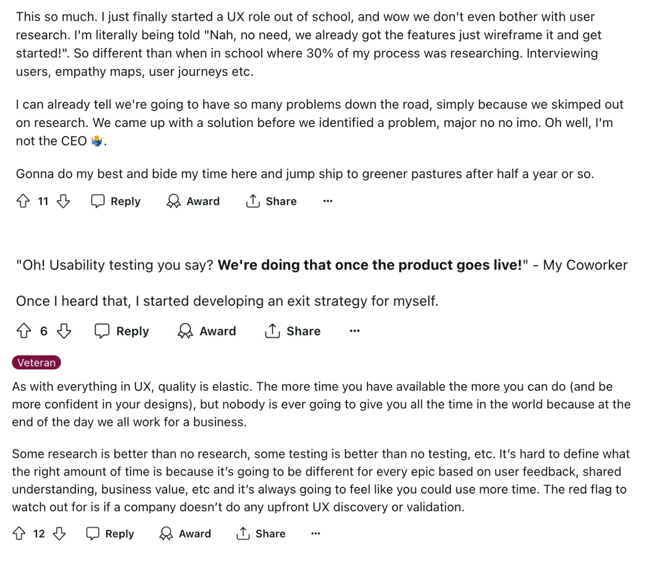What to do when you’ve done no research (yet) for your startup
That "ship fast" mentality might feel exhilarating, but it's like building a house without checking the foundation. Your product might stand... until it doesn't.
10/11/20244 min read


So, you’ve built your product based on gut feelings, a competitor audit, and maybe a sprinkle of intuition cause you are your target audience (ideal situation) or you know the user problem very well. Research? Oh, it was always on the to-do list, but time, money, and the “just ship it” mantra got in the way. And now? Your product might be working (or kind of working), but deep down, you know: you don’t actually know why.
Before you spiral into a black hole of what-ifs, take a breath. The fact that you’re even thinking about research now is a win. Let’s figure out how to approach this step-by-step without getting overwhelmed.
But first, let’s address the elephant in the room
"We don't need research, just ship it!"
The "No Research" Symptoms You're Probably Experiencing
Red Flags That Scream "We Needed Research":
Your team constantly debates what users want
Feature adoption rates are mysteriously low
Customer feedback feels like a surprise
Your roadmap is based on competitor features
Support tickets keep highlighting the same issues
You might be asking: Is it too late to do research?
Short answer: Absolutely not. Long answer: The best time to start research was yesterday. But the second-best time is today. Startups evolve fast, and while you might have skipped research in the early days, starting now can give you clarity and confidence moving forward, especially since the stakes might be getting higher and higher.
Skipping research isn’t uncommon—many startups believe they’ll "validate as they go." While experimentation is great for iteration, it’s not a substitute for understanding your users on a deeper level. You rarely understand the why from an A/B testing of a feature. You might know which one to go with, which is valuable information but if you don't know why - that's no better than someone who randomly hit a jackpot.
Where to start when you’ve done no research
The idea of "doing research" can sound vague and intimidating. But it doesn’t have to be. Here’s your roadmap to start without losing your mind:
1. Understand your users (properly this time)
You probably have some idea of who your users are. Now’s the time to confirm or debunk those assumptions. Start with:
Who are they? Demographics, behaviours, goals, and pain points.
Why are they here? What problem is your product solving for them—or not solving?
💡 Pro Tip: Start small. Conduct 5-10 interviews with real users. Listen to their stories, frustrations, and moments of delight. This alone can uncover game-changing insights.
2. Validate your assumptions
Your product was likely built on assumptions. It’s time to test them:
What did you assume about your users’ needs?
Did those assumptions hold up?
Are there blind spots you didn’t anticipate?
Run qualitative interviews or even quick usability tests to see where your product aligns (or doesn’t) with user expectations.
3. Prioritize Foundational Research
If you’re venturing into new strategies, features, or markets, foundational research is your best friend. It helps you answer the big questions about your users and their context before you get bogged down in specifics. Also, it's a great asset that can grow over time as you do more research and gather more knowledge naturally. It usually works like a repository or library that people can go to to get informed, align on things or simply get inspired!
💬 Here’s the tea: Foundational research can feel slow, but it’s worth it. Think of it as setting the stage for more informed decisions.
The Early Stage Smart startup's research playbook
Quick wins for immediate impact:
Start with guerrilla research - it's fast, cheap, and surprisingly effective. Interview five users this week. Yes, this week. Record their screens while they use your product. Watch in silence (this part is harder than you think).
The Money-Saving research stack:
User interviews (5-7 is your magic number)
Session recordings (tools like Hotjar are your friend)
Support ticket analysis (gold mine of insights)
Quick usability tests (even with your team's friends)
Competitor experience mapping
Pro Move: Create a "Research Light" ritual - 2-hour research sessions every two weeks. It's like compound interest for your product decisions.
Why Start with Qualitative Research?
Quantitative data (like surveys) might seem tempting, but unless you’re experienced in creating airtight questions and avoiding bias, it’s easy to collect a lot of... noise.
Qualitative methods—interviews, focus groups, or even open-ended feedback—are easier to start with and often richer in insights. Humans are naturally pretty good at talking to each other, so lean into that. The key? Stay objective and focused on your goals.
The Golden Rule: START SMALL AND BUILD CONFIDENCE
You don’t need a 30-page research strategy or a dedicated team to begin. Pick one area of uncertainty and start digging:
Why are users dropping off here?
What motivates them to click that button?
What’s stopping them from upgrading?
Gather insights, act on them, and repeat. Over time, you’ll build a rhythm (and a case for more research investment).
The ROI you can't ignore - When to absolutely stop and research:
Before raising your next round (VCs are increasingly looking for evidence-based product development. Show them your research insights, and you're speaking their language.)
Before building that "game-changing" feature
When user complaints follow a pattern
Before pivoting your strategy
When growth mysteriously plateaus
Think of research as your startup's insurance policy.
For every dollar spent on research, you're saving $10-100 in development costs and market corrections.
If you’ve avoided research until now, don’t beat yourself up. Starting late is better than never. Approach it with curiosity, humility, and a sense of adventure. After all, every piece of insight brings you closer to creating something users truly love.
Remember: A little research goes a long way. Start small, stay curious, and watch your product (and confidence) grow.


Source: Reddit


